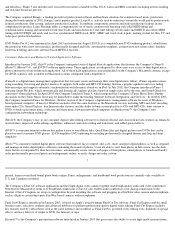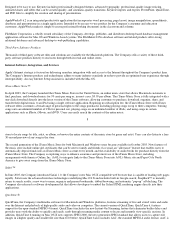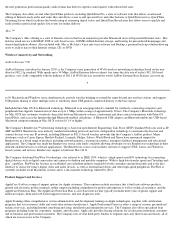Apple 2003 Annual Report Download - page 18
Download and view the complete annual report
Please find page 18 of the 2003 Apple annual report below. You can navigate through the pages in the report by either clicking on the pages listed below, or by using the keyword search tool below to find specific information within the annual report.
Net gains before taxes related to the Company's non
-current debt and equity investments of $10 million, $75 million, $367 million, and
$230 million were recognized in 2003, 2001, 2000, and 1999, respectively. A net loss before taxes related to the Company's non-current debt
and equity investments of $42 million was
19
recognized in 2002. In 2002, the Company acquired Emagic resulting in a charge of approximately $1 million for acquired in-process
technologies with no alternative future use. The Company recognized a similar charge of $11 million in 2001 related to its acquisition of
PowerSchool. Net charges related to Company restructuring actions of $26 million, $30 million, $8 million, and $27 million were recognized
in 2003, 2002, 2000, and 1999, respectively. During 2000, the Company recognized the cost of a special executive bonus for the Company's
Chief Executive Officer for past services in the form of an aircraft with a total cost to the Company of approximately $90 million. In 2002, of
the original $90 million accrual, $2 million remained unspent and was reversed. In 2003, settlement of the Company's forward stock purchase
agreement resulted in a gain of $6 million. Favorable cumulative-effect type adjustments of $1 million and $12 million were recognized in
2003 and 2001, respectively.
Item 7. Management's Discussion and Analysis of Financial Condition and Results of Operations
This section and other parts of this Form 10-K contain forward-looking statements that involve risks and uncertainties. Forward-looking
statements can also be identified by words such as "anticipates," "expects," "believes," "plans," "predicts," and similar terms. Forward-
looking
statements are not guarantees of future performance and the Company's actual results may differ significantly from the results discussed in the
forward
-looking statements. Factors that might cause such differences include, but are not limited to, those discussed in the subsection entitled
"Factors That May Affect Future Results and Financial Condition" below. The following discussion should be read in conjunction with the
consolidated financial statements and notes thereto included in Item 8 of this Form 10-K. All information presented herein is based on the
Company's fiscal calendar. The Company assumes no obligation to revise or update any forward-looking statements for any reason, except as
required by law.
Critical Accounting Policies
The preparation of financial statements and related disclosures in conformity with U.S. generally accepted accounting principles and the
Company's discussion and analysis of its financial condition and results of operations requires the Company's management to make judgments,
assumptions and estimates that affect the amounts reported in its consolidated financial statements and accompanying notes. Note 1 of the
Notes to Consolidated Financial Statements in Item 8 of this Form 10
-K describe the significant accounting policies and methods used in the
preparation of the Company's consolidated financial statements. Management bases its estimates on historical experience and on various other
assumptions that it believes to be reasonable under the circumstances, the results of which form the basis for making judgments about the
carrying values of assets and liabilities. Actual results may differ from these estimates.
Management believes the following to be critical accounting policies. That is, they are both important to the portrayal of the Company's
financial condition and results, and they require management to make judgments and estimates about matters that are inherently uncertain.
Revenue Recognition
Net sales consist primarily of revenue from the sale of products (i.e., hardware, software, and peripherals), and extended warranty and support
contracts. The Company recognizes revenue pursuant to applicable accounting standards, including Statement of Position (SOP) No. 97-2,
Software Revenue Recognition , as amended, and Securities and Exchange Commission (SEC) Staff Accounting Bulletin (SAB) No. 101,
Revenue Recognition in Financial Statements
.
The Company recognizes revenue when persuasive evidence of an arrangement exists, delivery has occurred, the sales price is fixed or
determinable, and collection is probable. Product is considered delivered to the customer once it has been shipped, and title and risk of loss
have been transferred. For most of the Company's product sales, these criteria are met at the time the product is shipped. For online sales to
individuals, for some sales to education customers in the United States, and for certain other sales, the Company defers revenue until the
customer receives the product because the Company legally retains
20
a portion of the risk of loss on these sales during transit. If at the outset of an arrangement the Company determines the arrangement fee is not,
or is presumed to not be, fixed and determinable, revenue is deferred and subsequently recognized as amounts become due and payable.
The Company records reductions to revenue for estimated commitments related to price protection and for customer incentive programs,
























